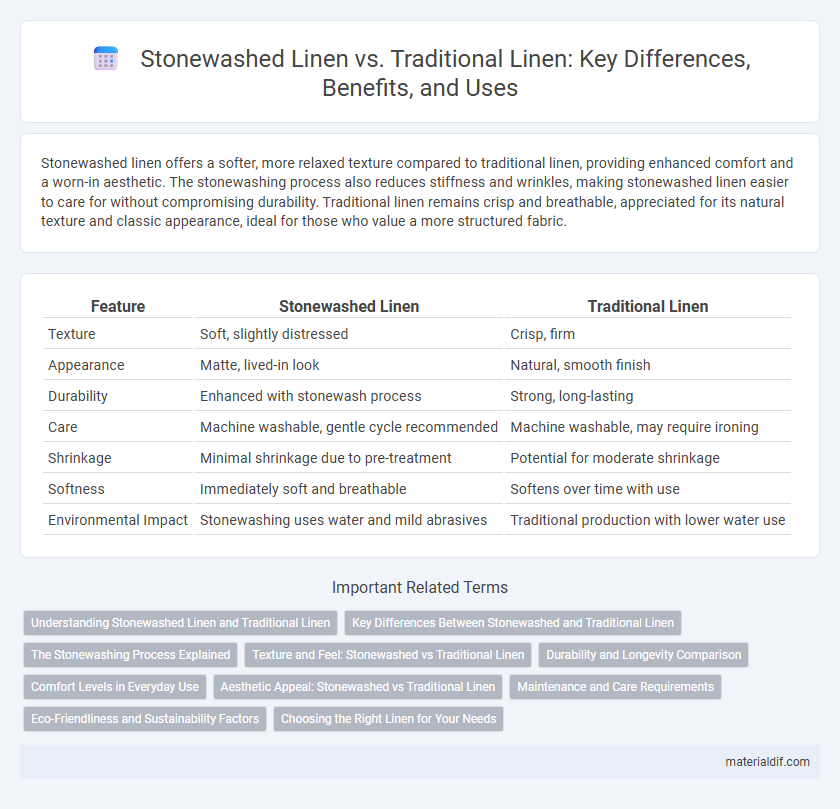Stonewashed linen offers a softer, more relaxed texture compared to traditional linen, providing enhanced comfort and a worn-in aesthetic. The stonewashing process also reduces stiffness and wrinkles, making stonewashed linen easier to care for without compromising durability. Traditional linen remains crisp and breathable, appreciated for its natural texture and classic appearance, ideal for those who value a more structured fabric.
Table of Comparison
| Feature | Stonewashed Linen | Traditional Linen |
|---|---|---|
| Texture | Soft, slightly distressed | Crisp, firm |
| Appearance | Matte, lived-in look | Natural, smooth finish |
| Durability | Enhanced with stonewash process | Strong, long-lasting |
| Care | Machine washable, gentle cycle recommended | Machine washable, may require ironing |
| Shrinkage | Minimal shrinkage due to pre-treatment | Potential for moderate shrinkage |
| Softness | Immediately soft and breathable | Softens over time with use |
| Environmental Impact | Stonewashing uses water and mild abrasives | Traditional production with lower water use |
Understanding Stonewashed Linen and Traditional Linen
Stonewashed linen undergoes a special washing process that softens the fabric, reduces stiffness, and creates a worn-in texture, making it more comfortable and breathable compared to traditional linen. Traditional linen, made from flax fibers, retains a firmer texture with natural slubs and a crisp feel, offering durability and a classic look but less softness initially. Understanding these differences helps in choosing between the relaxed, cozy aesthetic of stonewashed linen and the refined, sturdy quality of traditional linen for various textile or home decor applications.
Key Differences Between Stonewashed and Traditional Linen
Stonewashed linen undergoes a special washing process that softens the fabric, reduces stiffness, and creates a naturally worn-in texture, whereas traditional linen retains its crispness and structure. The stonewashing method also enhances color vibrancy and gives the fabric a slightly faded, vintage appearance, while traditional linen maintains a fresh, bright look. In terms of durability, stonewashed linen tends to be more pliable and less prone to wrinkles, contrasting with the firmer, more rigid characteristics of traditional linen.
The Stonewashing Process Explained
The stonewashing process involves washing linen fabric with natural stones or abrasive materials to create a soft, worn-in texture and a faded, vintage look. This technique enhances linen's breathability and comfort by breaking down fibers slightly, unlike traditional linen which retains a stiffer, more structured feel. Stonewashed linen is prized for its relaxed appearance and improved softness, making it ideal for casual wear and home textiles.
Texture and Feel: Stonewashed vs Traditional Linen
Stonewashed linen features a softer, more relaxed texture with a subtly worn-in feel, enhancing comfort and reducing stiffness commonly found in traditional linen. Traditional linen offers a crisper, firmer surface that highlights its natural fiber structure, providing a refined and breathable quality. The stonewashing process breaks down some of the linen's rigidity, resulting in a fabric that drapes more fluidly and feels smoother against the skin compared to the more textured and sturdy sensation of untreated linen.
Durability and Longevity Comparison
Stonewashed linen features enhanced durability due to the mechanical softening process that breaks down fibers slightly, making the fabric less prone to stiffness and tearing over time. Traditional linen retains a firmer texture, which can initially resist wear but may become brittle and prone to fraying with extended use. Overall, stonewashed linen offers greater longevity in everyday applications by maintaining softness and strength through consistent washing cycles, whereas traditional linen requires more careful handling to preserve its lifespan.
Comfort Levels in Everyday Use
Stonewashed linen offers enhanced softness and a relaxed texture compared to traditional linen, making it more comfortable for everyday wear and home textiles. The stonewashing process breaks down fiber stiffness, resulting in a fabric that feels smooth against the skin and requires less ironing. Traditional linen, while durable and breathable, tends to be stiffer and may need more care to achieve the softness desired for daily comfort.
Aesthetic Appeal: Stonewashed vs Traditional Linen
Stonewashed linen offers a softer, lived-in look with natural creases and a matte finish that enhances a casual, rustic aesthetic. Traditional linen maintains a crisp, smooth texture with a more structured appearance, ideal for formal or classic settings. The stonewashed finish produces a muted, vintage color palette, while traditional linen retains its vibrant, natural fibers for a brighter visual impact.
Maintenance and Care Requirements
Stonewashed linen requires less frequent ironing due to its pre-softened texture, making it easier to maintain compared to traditional linen, which tends to wrinkle more and demands regular pressing. Both types benefit from gentle washing with mild detergents, but stonewashed linen withstands multiple washes without significant fabric degradation or color fading. Proper drying, ideally air-drying away from direct sunlight, preserves the durability and aesthetic appeal of both stonewashed and traditional linen garments.
Eco-Friendliness and Sustainability Factors
Stonewashed linen offers enhanced softness and durability while maintaining eco-friendly qualities due to reduced chemical treatments compared to traditional linen, which relies more on intensive processing. The stonewashing process uses natural abrasives, minimizing water usage and pollution, thereby supporting sustainable textile production. Both fabrics are biodegradable and renewable, but stonewashed linen's gentler treatment aligns better with environmentally conscious consumers seeking sustainable fashion.
Choosing the Right Linen for Your Needs
Stonewashed linen offers a softer, more relaxed texture and reduced stiffness compared to traditional linen, making it ideal for casual wear and home textiles that require easy maintenance. Traditional linen, valued for its durability and crisp finish, suits formal garments and items requiring a polished look. Selecting between stonewashed and traditional linen depends on your preference for texture, care routine, and the intended use of the fabric.
Stonewashed Linen vs Traditional Linen Infographic

 materialdif.com
materialdif.com